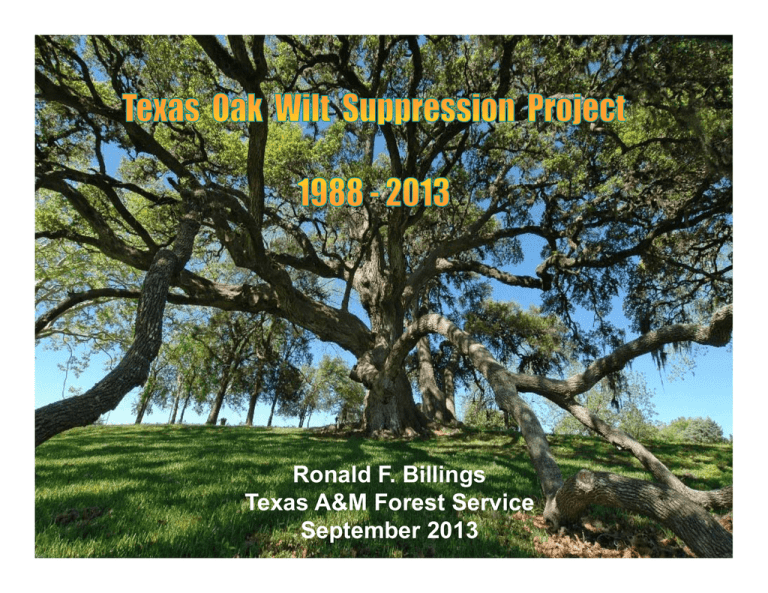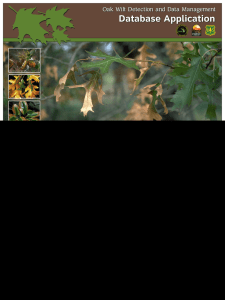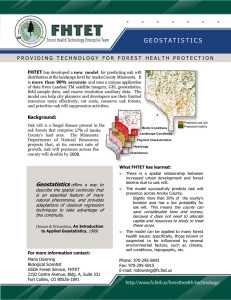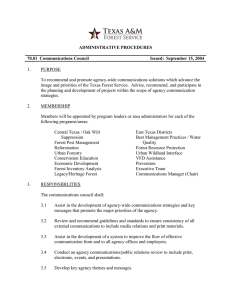Ronald F. Billings g Texas A&M Forest Service September 2013
advertisement

Ronald F. Billings g Texas A&M Forest Service September 2013 Oak Wilt in Texas • Oak wilt first identified in Texas in Dallas in 1961 • Prior to mid-1970s, live oak mortality in Central Texas was attributed to other causes Veinal necrosis on live oak • Live oaks and red (Spanish) oaks are most severely affected by oak wilt • Only red oaks produce fungal mats • Most tree losses occur from pathogen spread through interconnected root systems (common in live oaks) or root grafts grafts. Oak wilt fungal mat on red oak Background g • Initiated in 1988, by TFS & City of Austin following a 5-year federal:state Oak Wilt Demonstration Project Background g • Initiated in 1988, by TFS & City of Austin following a 5-year federal:state O k Wilt D Oak Demonstration t ti P Project j t • U.S. Congressman Jake Pickle instrumental in providing federal funding Background g • Initiated in 1988, by TFS & City of Austin following a 5-year federal:state O k Wilt D Oak Demonstration t ti P Project j t • U.S. Congressman Jake Pickle instrumental in providing federal funding • TFS or USFS had no previous presence in Central Texas Background g • Initiated in 1988, by TFS & City of Austin following a 5-year federal:state O k Wilt D Oak Demonstration t ti P Project j t • U.S. Congressman Jake Pickle instrumental in providing federal funding • TFS or USFS had no previous presence in Central Texas • Initial suppression efforts limited to Hood Hood, Travis, and Kendall counties Background g • Initiated in 1988, by TFS & City of Austin following a 5-year federal:state O k Wilt D Oak Demonstration t ti P Project j t • U.S. Congressman Jake Pickle instrumental in providing federal funding • TFS or USFS had no previous presence in Central Texas • Initial suppression efforts limited to Hood Hood, Travis, and Kendall counties • TFS staff in 1988 = one forester in Austin, urban foresters in Fort Worth and San Antonio. Distribution of Oak Wilt in Texas • 67 counties in Central July 2013 Texas Fort Worth Dallas College Station • 7 counties in West Texas Austin San Antonio Houston Counties in Texas with oak wilt cover an area larger g than VT,, NH,, MA, CT, NJ, RI and MD combined. Oak Wilt Project Administrators College Station - 2013 TFS Project Supervisors Tom Boggus State Forester Bill Oates Project Director Dr. Ron Billings Administrative Coordinator TFS Project Support Staff Dr. Brad Barber Technology Program Manager Sharon Klinker FRD Business Coordinator Aldyth Lewis FRD Office Associate Oak Wilt Project - TFS Staff in Central Texas 2013 VACANT Jim Rooni Regional Forester, Austin Michelle Gonzales FRD Business Associate, Austin James Houser Regional Forest Health Specialist Austin 10 Rachel McGregor Staff Forester I, Granbury Robert Edmonson Biologist III, Johnson City Renee Burks Staff Forester II, Hamilton Mark Duff Staff Forester II, San Antonio Eric Beckers Staff Forester II, Austin Daniel Lewis Staff Forester II, La Grange Texas A&M F T Forestt S Service i Central Texas Region Hamilton Region Ha mil to n Oak Wilt Technical Coordinators • 1988 - 1991 Dr. Scott Cameron • 1991 - 1998 Gene Gehring • 2000 - 2005 Kim Camilli • 2006 - Present James Houser Cooperators • A • USDA Forest Service/ Forest Health Protection • Cities, neighborhoods, private landowners • Texas A & M AgriLife Extension Service • Lady Bird Johnson Wildflower Center • Master Gardeners/Master Naturalists • ISA Certified Arborists Dr. David Appel, Texas A&M University Forest Pathologist Provides Technical Expertise Project Objectives • Increase public awareness about oak wilt • Detection D t ti and d evaluation l ti off oak k wilt ilt centers t • Provide technical assistance to landowners • Offer cost shares for oak wilt control • Train oak wilt specialists • Develop and implement strategic plan Increase Public Awareness of Oak Wilt Deal One-on-one with Affected Property Owners Oak Wilt Web Page Since 2003 A cooperative project involving: • Lady Bird Johnson Wildflower Center • Houston Advanced Research Center • National Biological Information Infrastructure • Texas A&M Forest Service • USDA Forest Service, Forest Health Protection • ISA, Texas Chapter http://texasoakwilt.org/ http://texasoakwilt.org Over 28,000 unique visitors and 86,000 page views from July 2012 to July 2013. Listed on Web Page as of July 2013 16 Oak Wilt Vendors;79 Oak Wilt Certified Arborists ISA Certified Arborist Training • Master Gardener/Master Naturalists Prevention State-of-the-art GIS and Data M Management S Systems DOQQ Photo Maps of Treatments Barrier Treatments • Trenching (at least 4 feet deep to halt oak wilt spread through connected root systems) • Roguing (removal of diseased trees within the trenched area) Oak Wilt Technical Advisory Board 2013 • Dr. Dave Appel, TAMU • James Houser, TFS • Dr. Brad Barber, TFS • Dr. Forrest Oliveria, • Dr. Ron Billings, TFS • Carrie Burns, Cityy of Lakewayy • Chris Dolan, City of Austin US Forest Service/ FHP • Jim Rooni, TFS • Dale Starkey, US Forest Service/FHP • Dr. Damon Waitt, i L.B.J.W.C. • Gene Gehring, Urban Renewal • R bG Rob Grotty tt , City of Austin In a cooperative effort involving the U.S. Park Service, an oak wilt center was treated on the LBJ Ranch at Stonewall, TX. Junction, Texas September 25, 2011 The 2011 drought made it difficult to detect and diagnose oak wilt centers. Junction September 25, 2011 Austin September 25, 2011 Centers trenched = 2,772 Feet of trench = 3.9 million feet (or 739 miles, equivalent to a trench running from Houston to El Paso) Total cost shares = $ 2.9 million Total costs = $ 7.4 million Success of trenches: 65-75% Feet of Cost-shared Trench by County 1988 - 2012 43 Counties Trenches by Land Use Classification T Texas Oak O k Wilt Suppression S i Project P j t FY07 FY08 FY09 FY10 FY11 60 % of total 50 40 30 20 10 0 Urban 1 Suburban Rural Res. Rural Non-Res. 2 3 4 Land Use Classification Cost-shared trenches only Cost/Foot of Trenches by Land Use Texas Oak Wilt Suppression Project FY07 FY08 FY09 FY10 FY11 $60.00 $50 00 $50.00 $40.00 $35.83 $30.00 $20.00 $10.00 $2.81 $4.93 $3.23 $0.00 Urban Cost-shared trenches only Suburban Rural Res. Land Use Classification Rural Non-Res. Cost-shared Cost shared Trenches by FFY Trenches 50 45 40 35 30 25 20 15 10 5 0 2007 2008 2009 2010 2011 2012 Mean Feet of C S Trenches by FFY C.S. Feet 90,000 , 80,000 70,000 60,000 50 000 50,000 40,000 30,000 20 000 20,000 10,000 0 2007 2008 2009 2010 2011 2012 Mean Cost Shares Paid by FFY Cost Shares Paid $140,000 $120 000 $120,000 $100,000 $80,000 $60,000 $40,000 $20,000 $0 2007 2008 2009 2010 2011 2012 Mean Suppression Project Budgets $600,000 $600 000 $500,000 $400,000 $300 000 $300,000 $200,000 $100,000 $0 Allocated Expended 2007 2008 2009 2010 2011 2012 2013 Suppression pp Project j Obstacles • Lack of State-mandated funding • Small S ll field fi ld staff t ff to t address dd a huge h problem bl • Increasing population pressure in rural areas • Demand for staff’s time from other programs p g • Cost of trenching has tripled since 1990 • Federal funding cut in half in 2012 and 2013 Cost-share Cost share Rates in FY 2013 40% of total costs, up to: • Maximum of $2,000 for single landowner per ffy • Maximum of $10 $10,000 000 for 5 or more landowners About Oak Wilt • Oak wilt impact has increased with a rapidlyincreasing gp population, p ,p property p y fragmentation, and urban sprawl. From 1980 to 2010, the population of Texas as a whole rose from 14.2 million to over 25 million,, or about 77% percent. p The five-county Th fi t Austin-Round A ti R dR Rock-San k S Marcos M area led l d the state in 30-year growth, with a population increase of more than 193 percent. Coordination with other TFS Programs g Oak Wilt Program Stewardship Program Urban Forestry Program Forest Health Invasive Species EAB Trapping Firewood Awareness Woodlands, Cross Timbers, and Drought Recovery Redesign Initiatives Long-range g g Strategic g Plan • Pursue integrated approach to pest management • Identification of priority areas, partnerships • Empower more cities & communities to address oak wilt • Involve and train volunteer groups to assist with Project goals • Plant resistant trees; diversify landscapes • Increase state funding


